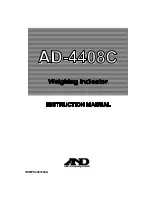
Periodic recalibration may be required by plants with
strict certification and traceability requirements. It is
always recommended that the user has the sensor
recalibrated periodically, particularly if the sensor
has experienced a very high shock level or extreme
temperatures for extended periods of time. Some
plants develop in-house calibration capabilities for
periodically
verifying
the
performance
of
accelerometers. Products are available that provide
a set 1 g-acceleration level at a fixed frequency for
quick sensor checking.
For these reasons, it is recommended that a
recalibration cycle be established for each
accelerometer. This schedule is unique and is based
on a variety of factors, such as extent of use,
environmental conditions, accuracy requirements,
trend
information
obtained
from
previous
calibration
records,
contractual
regulations,
frequency of “cross
-
checking” against other
equipment, manufacturer recommendation, and any
risk associated with incorrect readings. International
standards, such as ISO 10012-1, provide insight and
suggested methods for determining recalibration
intervals for most measuring equipment. With the
above information in mind and under “normal”
circumstances, a conservative suggestion of 12 to 24
month recalibration cycle for most piezoelectric
accelerometers is advised.
8.1 SENSOR CALIBRATION
Accelerometer recalibration services are typically
performed by IMI’s internal metrology laboratory.
(Other international and private laboratories are also
available.) The IMI laboratory is certified to ISO
9001, complies with ISO 10012-1 (and former MIL-
STD-45662A), and uses equipment directly traceable
to NIST. This assures an accurate calibration of
relevant specifications.
The following includes a broad overview of the Back-
to-Back Calibration technique normally used when
calibrating accelerometers. This technique provides
a quick and easy method for determining the
sensitivity of a test accelerometer over a wide
frequency range.
8.2 BACK-TO-BACK CALIBRATION THEORY
Back-to-back calibration is perhaps the most
common method for determining the sensitivity of
piezoelectric accelerometers. This method relies on
a simple comparison to a previously calibrated
accelerometer, typically referred to as a reference
standard, as shown in Figure 12.
Figure 12.
Reference Standard Accelerometer
These high-accuracy devices, which are directly
traceable to a recognized standards laboratory, are
designed for stability, as well as configured to accept
a test accelerometer. By mounting a test
accelerometer to the reference standard and then
connecting this combination to a suitable vibration
source, it is possible to vibrate both devices and
compare the data as shown in Figure 13. (Test set-
ups may be automated and vary, depending on the
type and number for accelerometers being
calibrated.)
Figure 13.
Typical Back-to-Back Calibration System
Because the acceleration is the same on both
sensors, the ratio of their outputs (V
T
/V
R
) must also
be the ratio of their sensitivities. With the sensitivity
of the reference standard (S
R
) known, the exact
sensitivity of the test sensor (S
T
) is easily calculated
by using the following equation:
𝑆
𝑇
= 𝑆
𝑅
(
𝑉
𝑇
𝑉
𝑅
)
By varying the frequency of the vibration, the sensor
may be calibrated over its entire operating
frequency range. The typical response of an
unfiltered accelerometer is shown in Figure 14.





































